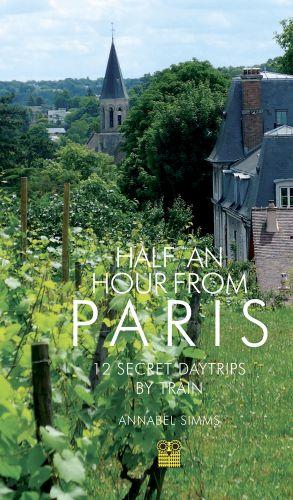
Map based upon data supplied by
Map based upon data supplied by

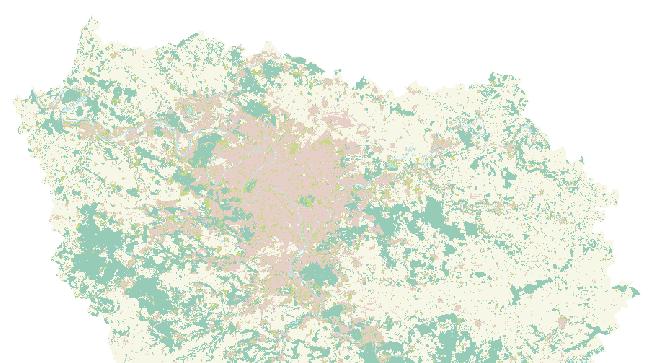


Royaumont
Giverny Giverny
Giverny
Giverny
Mantesla-Jolie
Pontoise
Auvers-sur-Oise
Ecouen
Poissy
Saint-Germainen-Laye
Marly-le-Roi
Malmaison
Parc de Bagatelle
Rambouillet

Parc Saint-Cloud
Parc Saint-Cloud
Versailles
Jouy-en-Josas
Igny
Vincennes
Dourdan
Etampes
Î


 Lagny
Meaux
La-Fertésous-Joarre
Neuillysur-Marne
Parc de la Poudrerie
Vincennes
Melun
Royaumont
Provins
Disneyland Paris
Esbly
Fontainebleau
Brunoy
Lagny
Meaux
La-Fertésous-Joarre
Neuillysur-Marne
Parc de la Poudrerie
Vincennes
Melun
Royaumont
Provins
Disneyland Paris
Esbly
Fontainebleau
Brunoy

Preface to the second edition
An Hour from Paris, a guide to 20 rewarding but little-known daytrips within an hour of Paris by train, first appeared in 2002 and is now in its third edition. I wrote the book I would have liked to have had in my hand when I first arrived in Paris from London in 1991. I needed to know how to get into the surrounding countryside by train, what was worth seeing, how long the journey would take, and how to get back without necessarily returning to my starting point. I also wanted enough local and historical information to appreciate the context of what I was seeing, a clear local map and directions, and honest comments on what I was likely to find en route, including food.
Part of my impulse to explore beyond Paris came from the need to get into the countryside and escape crowds, especially other visitors. So I also wanted to know which wild flowers and animals I might see. Ideally I wanted to be able to walk for pleasure as well as by necessity, if possible by a stream or river, but not for too long before reaching a café or a station.
No such book existed, so I started exploring the train network around Paris with a copy of the green Michelin guide to the Île de France in my hand instead. As it was written for car drivers many of its recommendations turned out to be impractical, but the places themselves were always rewarding. Some of them, such as Conflans-Sainte-Honorine, became the starting point for further explorations on foot as I began to appreciate just how interesting and accessible the Paris countryside is, and how little-known it is to most Parisians, let alone foreigners. It took several years of happy exploration and discovery before I realised that I had enough material to write the book I had always wanted to read.
The subsequent success of An Hour from Paris led many readers to ask for a sequel. I resisted this for some time, as their
Opposite: Porte du Cœur Volant, Parc de Marly

23

The Île de France: past and present
Place-names in bold are described in the text
A foreigner’s first impressions
When I first came to live in Paris I was puzzled by the phrase ‘Île de France’ (the ‘island of France’). I gradually realised that it referred to the area around Paris for a radius of about 80 kilometres (I was vague about this) and that les Franciliens, ‘the islanders of France’, meant the inhabitants of this region. Rather like Greater London, except that no one talks about Greater Londoners. I did not realise that the Île de France is almost eight times the size of Greater London, with a much better train service. Beyond noticing that it seemed to contain a lot of famous places, which I felt slightly guilty about not wanting to visit (Versailles, Fontainebleau, Barbizon), I had no clear idea of it as a region, nor did I feel the need for one. When I thought of the French countryside, I thought of the South of France, the Auvergne, the Loire, Burgundy, Brittany and, at a pinch, Normandy, which really seemed too close to England to count.
I also began to think of the area around Paris as the banlieue (a much more negative word than ‘suburb’) with an authentically Parisian shudder of fear, pity or contempt. My Paris, real Paris, did not extend beyond zone one of the Carte Orange, now replaced by the Passe Navigo, the métro and bus pass covering up to five zones around Paris. The limits of Zone One are still those of the old city boundary, traceable by the circle of métro stations beginning with the word Porte, indicating the entrance gates that were once part of the walls surrounding the city. I had assumed that these gates had disappeared
Opposite: The remains of a 13th-century church in the toilettes of the Brasserie Saint Furcy, Lagny-sur-Marne

29

1. Parc de la Poudrerie
The astonishing remains of a 19th-century gunpowder factory in deep woodland by a canal close to Paris
I was shown the Parc de la Poudrerie by a Paris friend who used to live nearby. Only locals seem to know about it and, as it is in a densely populated suburb not far from Clichy-sous-Bois where the 2005 Paris riots started, I was completely unprepared for the mysterious and beautiful experience it turned out to be. Within five minutes of leaving the station you are in another world, where the tranquil canal mirrors the reflections of the trees and sky, disturbed only by the passage of a pair of exotic mandarin ducks or the scurrying of a water vole. Violets, primroses and cowslips grow along the towpath. A little further on, the dignified brick and stone remains of the abandoned gunpowder factory above the canal blend harmoniously into the ancient woodland which makes up a large part of the 137 hectare park, full of wood anemones and bluebells in spring and the tapping sound of woodpeckers. It is listed as of outstanding natural interest because the deliberately scattered buildings, laid out in a fan shape to minimise damage in case of an accidental explosion, and the undisturbed woodland containing a variety of ancient trees and three ponds, have favoured species such as butterflies, weasels, red squirrels, pipistrelle bats, newts, salamanders, beavers, woodpeckers and falcons which are not usually found in urban areas. About 30 of the original 300 buildings have been saved from demolition, one housing a small technical museum, and another used for temporary exhibitions. The park is popular with local families as well as naturelovers, as it has something for everybody: romantically decaying buildings emerging from the trees, a buvette, cycle paths, a

49
Opposite: Parc de la Poudrerie
5. Neuilly-sur-Marne
An easy tranquil walk to a little-known guinguette on the Marne and along the rural Canal de Chelles
The modern commuter town of Neuilly-sur-Marne is so close to Paris that you will be pleasantly surprised to find yourself enjoying a peaceful stroll along the river within minutes of getting off the train. The guinguette (riverside restaurant where people go to dance) is only a short distance from the station, but in a different world. The nearby marina gives it a holiday atmosphere and unlike the better-known establishments near Joinville, it is mainly patronised by locals.
If you are pressed for time you could return to Paris the way you came, but it is well worth prolonging the walk along the surprisingly rural Canal de Chelles, where you will meet only a few strollers. From there it is a short bus ride to the station at Chelles-Gournay or you could walk the two kilometres to the station through a quiet residential quarter, peeping into well-kept suburban gardens. There is a popular café with a terrace in front of the station, with a relaxed, almost provincial atmosphere.
Les guinguettes
Guinguettes (pronounced ‘gang-ETTE’) are traditional modestlypriced restaurants by the river where people go to dance. One theory is that they are so called because le petit blanc, the white wine of the Paris region they served, made people giguet (ready to dance a jig). Scores of open-air restaurants serving this wine and its traditional accompaniment, la petite friture (tiny fried fish, usually whitebait) opened along the banks of the Seine and especially the Marne in the 19th century to avoid the tax on
90
goods coming into the capital. Working Parisians would spend Sunday afternoons beside the river, eating, drinking and listening to popular songs played on the accordion, until they felt ready to get up and dance.
Attracting artists as well as artisans, the guinguettes recall the atmosphere of the inter-war years, evoked by the songs of Edith Piaf, the films of Marcel Carné and the novels of Georges Simenon, all of whom came under their spell. Although these days most of them are no longer particularly cheap, they are always cheerful and they have never entirely disappeared from the affection of Parisians, despite the lure of television which nearly killed them off in the 1960s. In fact, in the last 30 years or so there has been a revival of the tradition, with the long-established guinguettes at Joinville now featuring in the guidebooks and a newer one on an island at Champigny, the Île du Martin-

neuilly-sur-marne 91
Guinguette Chez Fifi
RIVER ENRAM D934 Neuilly-sur-Marne to Chelles 0 1 km GARE RER/SNCF CHELLES-GOURNAY Gagny NeuillyPlaisance Neuillysur-Marne Chelles Gournaysur-Marne bus 113 TO PARIS TO MEAUX AV ROGER SALENGRO CANAL DE CHELLES ‘Chez Fifi’ park GARE RER LE CHENAYGAGNY GARE RER NEUILLYPLAISANCE GARE RER GAGNY lock
Pêcheur, attracting a younger clientèle. Chez Fifi, described below, is resolutely anchored in the 1960s and 70s, and its prices are still modest.
4 km walk from Neuilly-Plaisance station to Pointe de Gournay bus stop
Leave the station via the exit marked ‘Sortie 2, Boulevard Gallieni’, go through the ticket barrier and walk down a further flight of steps. At the bottom of the steps ignore the walkway directly in front of you and turn round to the left until you are facing in the opposite direction. You will see a discreet red and white GR sign (see pp. 177-178) facing you, in the right hand corner of what appears to be a dead end, but isn’t. Continue straight on, beneath the railway line overhead which crosses the river ahead of you. The walkway ends in steps down to the water’s edge, where you are immediately in another world, with the quiet spacious river glittering in front of you.
Turn left and walk along the Marne for a kilometre, passing a few strollers and joggers and the occasional water-skier in summer, until you come to Chez Fifi, just after the fourth bridge. It has tables outside, a dance floor inside and accordion music with live bands at the weekends.
The clientèle is mainly local and over 60, although there is a sprinkling of younger people. The plump patron waiting on clients in his cloth cap is instantly recognisable, as there is a picture of him over the entrance next to the legend ‘l’Ambiance d’Autrefois’ (‘the Atmosphere of Times Gone By’). This claim is borne out to a certain extent by the décor, the women’s dresses, the 1960s music, the traditional menu and the prices. The food is certainly not haute cuisine but the friture d’éperlans (fried smelt, tiny fish very similar to whitebait) was garnished with garlic and parsley, and the moules-frites were freshly made. The waiter was so rushed off his feet by a large group celebrating a birthday that our friture and wine arrived without the bread and I despaired of ever getting any, after two fruitless visits to the kitchen and frantic reassurances by the waiter. Our newly-arrived
neuilly-sur-marne 93
8. Château de Vincennes
A 14th-century royal fortress, lunch in a 1950s brasserie and an optional woodland walk through the Bois de Vincennes to the abandoned colonial pavilions of the Jardin Tropical
Situated just outside Paris in the Bois de Vincennes, the Château de Vincennes has preserved its 14th-century appearance, a walled fortress surrounded by parkland. Rather like the Tower of London, it has been in turn royal residence and stronghold, seat of government, prison and arsenal and is now a state-run museum. Perhaps because it is so close to Paris it is often overlooked, by Parisians and foreign visitors alike. Their loss, your gain.
Lunch in the long established two-star hotel-brasserie opposite the métro, surrounded by local families, feels like eating in a traditional Paris brasserie, c. 1950. Its splendid art deco circular skylight, cosy seating, traditional menus, reasonable prices and unpretentious ambiance add to the pleasure of discovering the château. You could round off the visit by taking a woodland path through the Bois de Vincennes, past a boating lake to visit the abandoned pavilions of the 1907 ‘Exposition Coloniale’, hidden in the Jardin Tropical on the edge of the Bois and a rather wellkept secret, returning to Paris from the nearby RER station of Nogent-sur-Marne.
The Château de Vincennes
The development of a 12th-century hunting lodge in the Bois of Vincennes into an important fortified royal residence in the 14th century was probably the result of two factors: the absorption of the nearby county of Champagne into the kingdom of France in 1284, increasing the importance of Paris; and its convenient location close to the River Seine and the old Roman road from
116
Paris to Sens. This allowed the medieval monarchs easy access to other parts of their kingdom and enabled the necessary supplies to reach the château.
It was and still is dominated by the 50-metre high donjon (castle keep), the castle within a castle which is the tallest building of its type still standing in Europe and the highlight of the visit. The decision to fortify Vincennes was a result of the Hundred Years’ War with the English, during which Jean II (‘Le Bon’, 1350-1364) was taken prisoner and had to be ransomed at vast expense. The need to protect the king and the access to Paris, as well as explosive social unrest at home, in the shape of the bourgeois revolt in Paris led by Etienne Marcel and ‘la Jacquerie’, the peasants’ revolt north of Paris, both in 1358, explain the speed and thoroughness with which the work was carried out. The donjon was started in 1361 and completed by 1371 under Charles V (‘Le Sage’, 1364-1380) and the deep moat and three-metre thick walls incorporating nine towers 40 metres high surrounding the whole complex were finished by 1380.
The donjon was used by Charles V to run his medieval kingdom from a permanent impregnable base: his private
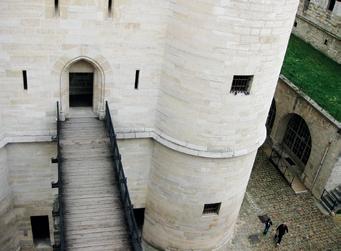
château de vincennes 117
The bridge to the donjon, Château de Vincennes
9. Parc Saint-Cloud
A short walk of discovery through a historic but littleknown park overlooking the Seine at Sèvres near Paris, past two very different museums and the old town of Saint-Cloud
On a hill overlooking a bend of the Seine to the west of Paris, the vast Parc Saint-Cloud, which once surrounded a royal château, is nowadays mainly frequented by locals. But this short bucolic walk with its sweeping views of the river and the city offers Parisians and visitors a real sense of dépaysement (‘change of scene’), at the end of a métro line.
En route you are transported from the classical 17th century French formality of the Grande Cascade waterfall with its panoramic views of Paris to the romantic hilltop Jardin de Trocadéro designed à l’anglaise in the early 19th century as a private retreat for the children of the royal family. At the start and end of the walk you will pass two interesting and very different museums, with the chance to see some beautiful Sèvres porcelain. The walk continues through the quiet little streets of the old hillside town of Saint-Cloud with its church containing the relics of the sixthcentury saint who gave the town and the park his name. From there you descend by a series of steps to a range of transport options, including the 72 bus which follows the right bank of the Seine in Paris from the Pont Mirabeau to the Île St Louis, giving you an armchair view of some of the city’s most iconic sights.
3½ km walk from Pont de Sèvres to Saint-Cloud
Take métro line 9 to its terminus at Pont de Sèvres and leave by exit 2, quai Alphonse Le Gallo. Turn left, cross the road and turn right onto the main road leading to the Pont de Sèvres, staying on the right-hand side across the bridge.
128
You will see an egg-shaped glass-covered dome to your left on the Île Séguin, a useful landmark. It is the auditorium of La Seine Musicale, a music and performing arts centre which opened in 2017. The building ahead on the other side of the river, surmounted by a clock and looking rather like a 19th century railway station, is the Musée de Sèvres on the edge of the Parc Saint-Cloud.
Ignore the steps down from the bridge marked ‘Musée de Sèvres’. Instead, continue a little way and at the bus stop turn right to follow the pedestrian signs for ‘Musée Céramique’ downhill. This walkway takes you over the busy main road to the museum entrance.

The museum’s huge national collection has been organised to tell the story of the art of pottery, with beautiful examples drawn from every period and every country, but with pride of place given to the porcelain which has been produced at the stateowned Manufacture de Sèvres since 1759. It is never crowded and well worth a visit, even a brief one, to see some masterpieces of the potter’s art displayed in their historical context.
Turn left from the entrance and continue to a gate which
parc saint-cloud 129
Etienne Allegrain, ‘View of château and park at St-Cloud’, 1675
until you come to the Grille de Sèvres entrance to the Parc de Bagatelle.
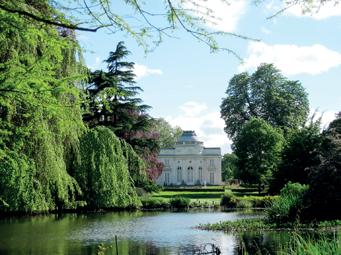
From here turn sharp right, past the boutique, les toilettes and the restaurant, and on through a long narrow garden planted with arbours of wisteria, with roses and clematis climbing the wall on your right. Go straight on and through the next garden which becomes a jardin potager (kitchen garden, where I filched a raspberry), then past a bamboo grove at the end.
The Jardin des Iris lies just beyond this, slightly hidden, with the entrance on the right. There are benches at the less visited far end in front of a little fountain, an idyllic place in which to picnic. When I bent down to sniff the irises one crowded sunny Sunday in May (each colour has a slightly different smell) all the elegant seizième old ladies started doing the same. Seizième just means ‘sixteenth’ but to Parisians is a loaded adjective, evoking the old wealth traditionally associated with this arrondissement.
The Roseraie for which Bagatelle is famous is opposite the iris garden but to my mind not as unusual or rewarding, although of course a rose is always a rose, and there are around ten thousand of them, representing 1,200 species. Go through it
half an hour from paris 140
Château de Bagatelle
and towards the Orangerie on your left. At this point you could veer left to return to the entrance and the château nearby, but it is well worth following the map for a rewarding ramble in the park.
I particularly recommend the Grotte Cascade Pièce d’Eau des Cygnes Noirs (‘grotto and waterfall at the lake of black swans’) for its dramatic water effects and the quiet buvette with its elegant wooden furniture shaded by green parasols near the ‘Grand Rocher’ where you can order a beer or a coffee to accompany your picnic, and perhaps share it with the peacocks and the ducks. It is also well worth a detour to the Cascade Pièce d’Eau des Nymphéas (‘waterfall at the water-lily lake’) for the pleasure of using the stepping stones across the water to sit in a ‘secret’ rocky grotto, watching the ducks and coots and an occasional heron. You can see the little château de Bagatelle from here, not far from the park entrance. It cannot be visited but you can peep through the windows to admire the 18th century furnishings. It has the Latin words Parva sed apta carved over the front (‘small but appropriate’).
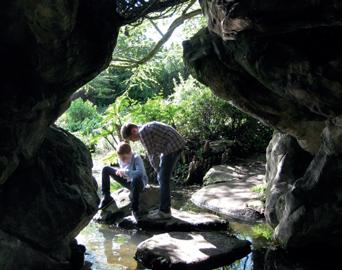
parc de bagatelle 141
Cascade des Nymphéas
A unique glimpse into the private lives of Napoleon and Josephine at the château de Malmaison. Optional stroll through the park for lunch in the historic centre of Rueil opposite the church where Josephine is buried and riverside walk to Rueil-Malmaison
The elegant little château de Malmaison is in a lovely setting within easy reach of Paris, which is why Napoleon and Josephine chose it, but has few international visitors. You could enjoyably prolong this trip by taking a short walk through the Parc de Bois-Préau next door, which once belonged to the château, to the church where Josephine is buried in the historic centre of Rueil. It is an attractive little town with a market and a good brasserie next to the church. You could end the trip with a short bus ride to Bougival to take a beautiful 3 km walk back along the Seine at a spot made famous by the Impressionists, past the house of Georges Bizet to the station at Rueil-Malmaison.
Napoleon and Josephine at Malmaison
The more you know about Napoleon and Josephine, the more rewarding the visit will be. These two highly successful self-made people had a lot in common and each died with the other’s name on their lips. Josephine de Beauharnais was a 32-year old widow with two children, from a minor aristocratic family in Martinique, living on her beauty and her wits in the precarious world of the Directory which governed France from 1795 to 1799. She was six years older than the rising but socially unpolished young general when he met and fell in love with her. They married a few months later in 1796 despite the opposition of his family, who felt that he could have done much better. It seems that she was not in love
144 11.Malmaison
with him and that Napoleon was furious when he found out about at least one lover soon after their marriage. He turned out to be a devoted step-father to Josephine’s children and all the evidence is that she eventually fell deeply in love with him. The divorce in 1809 was reluctantly arranged so that he could marry again when it was clear that she could not provide the Emperor with an heir. He made a generous settlement on her, including Malmaison and its valuable contents, insisted that she keep the title of Empress, and continued to support her financially despite her extravagance. He once remarked that the only thing that ever came between them was her debts. They stayed good friends until her death at Malmaison, aged 51, in 1814. After his abdication on 22 June 1815 Napoleon spent a few days at Malmaison before leaving France for exile on St Helena.
The 17th-century château was acquired by Josephine in 1799 and Napoleon paid for it on his return from Egypt. He employed two young architects, Percier and Fontaine, to do major renovation work on it between 1800 and 1802 although he curtailed their more ambitious plans to remodel it completely. Unlike Rambouillet and St-Cloud, former royal châteaux which
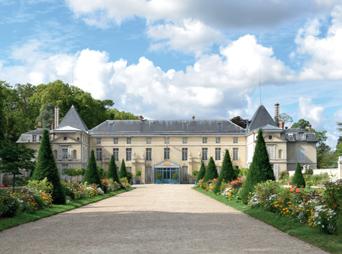
malmaison 145
Château de Malmaison







 Lagny
Meaux
La-Fertésous-Joarre
Neuillysur-Marne
Parc de la Poudrerie
Vincennes
Melun
Royaumont
Provins
Disneyland Paris
Esbly
Fontainebleau
Brunoy
Lagny
Meaux
La-Fertésous-Joarre
Neuillysur-Marne
Parc de la Poudrerie
Vincennes
Melun
Royaumont
Provins
Disneyland Paris
Esbly
Fontainebleau
Brunoy









